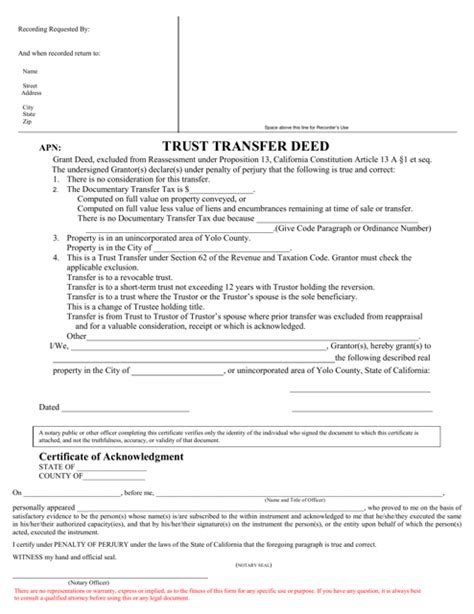How To Fund A Trust In California
Ronan Farrow
Mar 31, 2025 · 3 min read

Table of Contents
How to Fund a California Trust: A Comprehensive Guide
Funding a trust in California involves transferring assets into the trust's ownership. This process, while seemingly straightforward, requires careful planning and execution to ensure legal compliance and tax efficiency. This comprehensive guide will walk you through the steps, highlighting key considerations for various asset types.
Understanding the Different Ways to Fund a Trust
There are several methods for funding a California trust, each with its own implications:
1. Funding During the Grantor's Lifetime (Inter Vivos Funding):
This is the most common method. Assets are transferred to the trust while the grantor (the person creating the trust) is still alive. This offers several advantages, including:
- Control: The grantor retains control over the assets while alive, often serving as the trustee.
- Estate Planning Benefits: It can help avoid probate, reducing costs and time delays upon death.
- Asset Protection: Depending on the trust type, it might offer protection from creditors.
How to do it: The specific process depends on the asset. It typically involves executing a deed, transferring title, or retitling assets in the trust's name. Professional guidance from an estate planning attorney is recommended.
2. Funding After the Grantor's Death (Testamentary Funding):
This method involves funding the trust upon the grantor's death, as outlined in their will. The executor of the will is responsible for transferring the assets to the trust. This method is less common than inter vivos funding because it requires the probate process to be completed.
How to do it: The will clearly designates the assets to be transferred and names the successor trustee. After probate, the executor is legally required to fulfill the instructions stated in the will.
3. Pour-Over Will:
This is a supplementary strategy, often used in conjunction with inter vivos funding. A pour-over will directs any assets not already transferred to the trust during the grantor's lifetime to be "poured over" into the trust upon death. This ensures that all assets are managed by the trust.
How to do it: Requires a properly drafted will explicitly stating the pour-over provision, ensuring seamless transfer of remaining assets.
Types of Assets and Funding Methods: A Detailed Breakdown
Funding a trust involves a variety of asset types. Here's a closer look at how to transfer each:
Real Estate:
Requires transferring the deed to the trust. An attorney is highly recommended to ensure proper documentation and compliance with legal requirements.
Bank Accounts:
Requires changing the account ownership to the trust's name. Contact the bank to understand their specific procedure.
Stocks and Bonds:
Most brokerage firms have a streamlined process for transferring securities into a trust name.
Retirement Accounts (IRAs, 401(k)s):
These accounts often have specific rules regarding beneficiary designations. It's crucial to work with a financial advisor to ensure proper transfer and avoid tax penalties.
Life Insurance Policies:
Requires changing the beneficiary designation to the trust.
Critical Considerations for Funding a California Trust
- Tax Implications: Transferring assets might have tax consequences, including gift or estate taxes. Seek expert advice from a tax professional.
- Legal Compliance: Ensure all documentation is accurate and legally sound. Any mistakes can lead to complications later on.
- Professional Advice: It's strongly recommended to consult with an estate planning attorney and a financial advisor to ensure proper execution and planning.
Conclusion: Ensuring a Smooth and Effective Trust Funding Process
Funding a California trust is a crucial step in effective estate planning. By understanding the different methods, asset types, and legal considerations, you can ensure a smooth process, protecting your assets and providing for your loved ones. Remember, seeking professional advice from attorneys specializing in estate planning and tax professionals will prove invaluable in navigating this complex process. This detailed guide provides a strong foundation for understanding the process. Always prioritize seeking personalized advice based on your individual circumstances.
Featured Posts
Also read the following articles
| Article Title | Date |
|---|---|
| How To Close A Saltwater Pool For Winter | Mar 31, 2025 |
| How To Clock A Gas Meter | Mar 31, 2025 |
| How To Get Wrinkle Out Of Carpet | Mar 31, 2025 |
| How To Find Dead Mouse In Car | Mar 31, 2025 |
| How To Get An Address For Land In Florida | Mar 31, 2025 |
Latest Posts
-
How Do I Identify My Antique Drawer Pulls
Apr 04, 2025
-
How Do I Identify An Artist Signature
Apr 04, 2025
-
How Do I Heal My Soul
Apr 04, 2025
-
How Do I Get To Bequia
Apr 04, 2025
-
How Do I Get The Alkalinity Down In My Pool
Apr 04, 2025
Thank you for visiting our website which covers about How To Fund A Trust In California . We hope the information provided has been useful to you. Feel free to contact us if you have any questions or need further assistance. See you next time and don't miss to bookmark.
